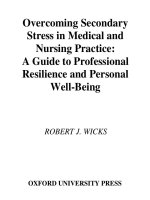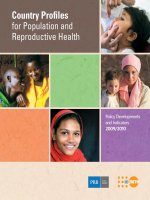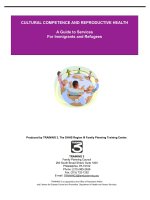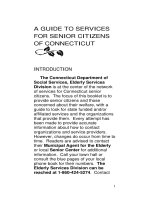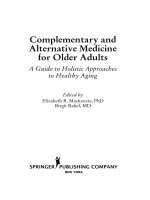QUALITATIVE RESEARCH FOR IMPROVED HEALTH PROGRAMS: A Guide to Manuals for Qualitative and Participatory Research on Child Health, Nutrition, and Reproductive Health doc
Bạn đang xem bản rút gọn của tài liệu. Xem và tải ngay bản đầy đủ của tài liệu tại đây (699.88 KB, 194 trang )
Prepared by
Department of International Health
Johns Hopkins University, School of Hygiene and Public Health
for
Support for Analysis and Research in Africa (SARA)
Academy for Educational Development (AED)
USAID, Bureau for Africa, Office of Sustainable Development
QUALITATIVE RESEARCH
FOR IMPROVED
HEALTH PROGRAMS:
A Guide to Manuals for Qualitative and Participatory
Research on Child Health, Nutrition, and
Reproductive Health
Qualitative Research for
Improved Health Programs
A Guide to Manuals for Qualitative and Participatory
Research on Child Health, Nutrition, and Reproductive
Health
Peter J. Winch, M.D., MPH
Jennifer A. Wagman, MHS
Rebecca A. Malouin, MPH
Garrett L. Mehl, MHS
January 2000
Prepared by
Department of International Health
Johns Hopkins University, School of Hygiene and Public Health
for
Support for Analysis and Research in Africa (SARA) Project
Academy for Educational Development
funded by
U.S. Agency for International Development
Africa Bureau, Office of Sustainable Development
Acknowledgments
The idea for this guide originated during a number of meetings in Africa, where the SARA,
BASICS, SFPS and other projects were promoting the use of qualitative and participatory
research methods for planning, implementing, and evaluating health programs. It became
apparent that most program managers and researchers interested in qualitative and participa-
tory research were unaware of the various manuals and tools already in existence, and,
therefore, were forced to “start from scratch” in developing their own protocols for data
collection. This manual aims to bring together—in one document—descriptions and order-
ing information about all the currently available manuals and guides on qualitative and
participatory research related to child health and nutrition and reproductive health.
The first draft of the guide was reviewed at a meeting organized by the SARA, SFPS, and
BASICS projects in Dakar, Senegal in July 1998. The dozen participants, representing a
diverse range of expertise, organizations, and disciplines, discussed ways to develop and
reinforce qualitative research competency in West Africa, including translating selected
manuals into French, and making these manuals more available to African researchers. The
participants concluded that by improving qualitative research capabilities, useful data would
result, thereby improving health programs and, eventually, health outcomes.
We would like to give sincere thanks to the following people who took the time to read
earlier drafts of the guide, giving invaluable guidance and suggestions: Lonna Shafritz,
Renuka Bery, and Suzanne Prysor-Jones of the SARA Project, who provided editorial and
technical feedback throughout the development of the guide; Carol Baume, Karabi
Bhattacharyya, Bérengère de Negri, and Elizabeth Thomas of the Academy for Educational
Development; and Patricia Hudelson of the World Health Organization.
This guide would not have been possible without the financial support from USAID, Bureau
for Africa, Office of Sustainable Development.
Contents
Foreword
Introduction i
Acronyms ii
SECTION I: Resources on Qualitative Research Methods 1
Chapter 1: General Resources for Qualitative Research on Health 3
Chapter 2: Methods for Focus Groups 13
Chapter 3: Methods for Qualitative Data Analysis 25
SECTION II: Manuals on Participatory Research 37
Chapter 4: General Resources on Participatory Research 39
Chapter 5: Manuals on Participatory Research Methods 51
Chapter 6: Manuals on Training in Participatory Research 71
SECTION III: Manuals on Specific Health Topics 87
Chapter 7: Three Types of Manuals on Specific Health Topics 89
Chapter 8: Acute Respiratory Infections (ARI) 95
Chapter 9: Malaria 105
Chapter 10: Water and Sanitation 124
Chapter 11: Diarrheal Diseases 137
Chapter 12: Nutrition 149
Chapter 13: Reproductive Health 163
Qualitative Research for Improved Health Programs: A Guide to Manuals
Foreword
This guide is designed for program managers, researchers, funders of health programs, and
others who are considering using qualitative research methods to help them design more
effective health programs and/or evaluate the strengths and weaknesses of existing programs.
It is assumed that the reader already has some familiarity with the basic methods in the
“qualitative research toolbox” such as in-depth interviews, focus groups, and participant
observation.
This guide describes some of the existing manuals for conducting qualitative research on
health and provides information to help would-be users select the manuals that are most
appropriate to their needs. This guide does not attempt to review the available qualitative
research tools related to prevention and treatment of chronic and non-infectious diseases,
including tobacco control, obesity prevention, or management of such diseases as diabetes or
epilepsy.
This guide is divided into three sections:
u Section I reviews general manuals on qualitative research in health and discusses computer
software available for qualitative data analysis.
u Section II reviews manuals of methods and training for participatory research.
u Section III reviews the available manuals on specific health topics such as child health,
nutrition, and reproductive health. Chapter 7 provides an overview of different ap-
proaches that have been taken to write manuals. Chapters 8-13 describe manuals on
specific topics such as malaria, nutrition, and reproductive health.
If you already have experience with qualitative research and are not interested in reading
general information on qualitative research methods and participatory research, proceed to
the specific chapters, focus on your particular area of interest. Ordering information for the
manuals and tools discussed in each chapter is found at the end of each manual’s description.
i
Introduction
Why are manuals needed for qualitative research?
There are many differences between qualitative and quantitative research. One of the
strengths of qualitative research methods is that they are exploratory and flexible. The results
of a quantitative survey, using closed-ended questions, provide public health planners and
programs with information about characteristics of the population on a set of predetermined
questions. Qualitative methods allow the researcher to ask questions of different people in
different ways, and to modify the questions and data collection methods to explore topics
that were not initially deemed important. Why are detailed manuals needed?
Manuals help qualitative researchers to focus on the key
issues to be investigated.
A good manual points the qualitative researcher toward the key issues to be investigated for a
given health problem. For example, clinical and epidemiological studies have shown that
very rapid breathing is a sign of pneumonia and other serious respiratory infections, indicat-
ing that a child should be treated immediately with antibiotics. Manuals on acute respiratory
infections (ARIs) direct the qualitative researcher to this particular point, and describe how
to explore how important people think it is, ways of learning the terms used to describe it,
and what kinds of treatment, if any, is sought for it.
Manuals describe proven methods to understand these
issues.
Most of the manuals described in this guide have undergone extensive pre-testing, in which a
manual is used in the field by local researchers to collect and analyze data. Results of these
field tests allow the authors of the manual to select the most effective methods and tech-
niques to obtain the requisite information and to improve the instructions for using these
methods. Pre-testing also allows the authors to determine the optimal sample size for each of
the procedures in the manual.
Manuals improve data analysis to provide (potential)
solutions to these issues.
Qualitative methods generate pages and pages of data. The results of many studies are never
used because the researchers did not plan enough time to analyze the data they collected, nor
do they know how to do it. Many manuals describe in detail how to analyze the data and
include forms for tabulating data. Some also describe how to prepare a report.
Qualitative Research for Improved Health Programs: A Guide to Manuals
ii
Acronyms
AED Academy for Educational Development
AFR/SD Africa Bureau/Office of Sustainable Development
AIDSCAP AIDS Control and Prevention Project
ALRI Acute Lower Respiratory Infection
AMREF African Medical and Research Foundation
ARI Acute Respiratory Infection
BASICS Basic Support for Institutionalizing Child Survival Project
CAM Cultural Anthropology Methods (Journal)
CAFS Center for African Family Studies
CATAD Center for Advanced Training in Agricultural Development
CDC Centers for Disease Control and Prevention
CRS Catholic Relief Services
CSSP Child Survival Support Project
CWM Community Wildlife Management
EPB Expanded Promotion of Breastfeeding
FES Focused Ethnographic Study
RES Rapid Ethnographic Study
FHI Family Health International
HEALTHCOM Communication for Child Survival Project
HHRAA Health and Human Resources Analysis for Africa
HIV/AIDS Human immunodeficiency virus/Acquired immune deficiency syndrome
HRD Human Resource Development
IDC Information Dissemination Center
IDS Institute for Development Studies
iii
IEC Information, education, and communication
IIED International Institute for Environment and Development
IMCI Integrated Management of Childhood Illness
IRC International Rescue Committee
IUNS International Union of Nutritional Sciences
JHPIEGO Johns Hopkins Program for International Education in Reproduction Health
JHU Johns Hopkins University
KIWASAP Kilifi Water and Sanitation Project
KPC Knowledge, Practice, and Coverage
LINKAGES Breastfeeding, Complementary Feeding, and Maternal Nutrition Project
MIS Management information systems
MOH Ministry of Health
NGO Nongovernmental organization
PCS Population Communication Services Project
PIDA Participatory and Integrated Development Approach
PLA Participatory Learning and Action
PLAN An international, humanitarian, child-focused development organization
PRA Participatory Rural Appraisal
PROWESS Promotion of the Role of Women in Water and Environmental Sanitation
Services
PVO Private Voluntary Organization
RAP Rapid Assessment Procedures
RCPLA Resource Centers for Participatory Learning and Action
REFLECT Regenerated Freirean Literacy through Empowering Community Techniques
RP Research Protocol
RRA Rapid Rural Appraisal
SANA Sustainable Approaches to Nutrition in Africa
Qualitative Research for Improved Health Programs: A Guide to Manuals
SARA Support for Analysis and Research in Africa
SFPS Santé Familiale et Prévention du SIDA (Family Health & AIDS
Prevention Project)
STD Sexually transmitted disease
STI Sexually transmitted illness
UNAIDS Joint United Nations programme on AIDS (Programme commun des
Nations Unies sur le VIH/SIDA (ONUSIDA))
UNFPA United Nations Fund for Population Activities
UNDP United Nations Development Programme
UNICEF United Nations Children’s Fund
USAID United States Agency for International Development
WHO World Health Organization
WHO/AFRO World Health Organization/Regional Office for Africa
WWW World Wide Web
iv
1
SECTION I: Resources on Qualitative Research
Methods
Section I is organized into three chapters:
Chapter 1—General Resources for Qualitative Research on Health will be of benefit to those
who have little or no experience with qualitative research methods. If qualitative research is
new to you or your personnel, you will need a book or manual that describes the basic
methods in the qualitative research toolbox, including how to use them and their strengths
and weaknesses. This chapter reviews a few selected introductory-level books and manuals on
qualitative research. Most are related specifically to health. This review does not pretend to
be inclusive, as hundreds of books exist on theoretical and practical aspects of qualitative
research.
Chapter 2—Methods for Focus Groups discusses the time and personnel needed for conduct-
ing focus group discussion research. The manuals on using this type of research method are
reviewed.
Chapter 3—Methods for Qualitative Data Analysis is organized into two parts Part I, Analyz-
ing textual data, reviews a number of options for analyzing textual data based on in-depth
interviews and focus group transcripts, such as: analysis by hand; analysis with word proces-
sors; analysis with search and retrieve programs (dtSearch and ZyIndex); programs for semi-
structured data (CDC EZ Text); and Integrated coding and model-building programs (The
Ethnograph Version 5.0, NUD*IST, and ATLAS/ti). Part II, reviews ANTHROPAC, a
software program for the analysis of systematic data.
Chapter 1: General Resources for Qualitative Research on Health
Overview of Resources for Qualitative Research on Health
1) RAP for Nutrition
and Primary Health
Care: Anthropologi-
cal Approaches to
Improving Program
Effectiveness,
Scrimshaw, SCM &
Hurtado, E. 1987, 70
pages.
A general introduc-
tion to qualitative
research methods
+
+++
+++
+
+
2) Qualitative
Research for
Health
Programmes,
Hudelson, P.
1996, 100
pages.
Comprehensive,
highly readable
introduction to
qualitative
research on
health
++
+++
—
—
+
3) Research
Methods in
Anthropology,
Qualitative and
Quantitative
Approaches,
Bernard, HR. 1994,
585 pages.
An introduction
and reference on
qualitative and
quantitative
methods used in
anthropology
+++
+++
—
—
++
4) RAP—Qualitative
Methodologies for
Planning and
Evaluation of
Health Related
Programmes,
Scrimshaw, NS &
Gleason GR. 1992,
528 pages.
Collection of
papers from 1990
International
Conference on
Rapid Assessment
Methodologies
+
—
—
—
+++
5) Population and
Reproductive Health
Programmes: Apply-
ing Rapid Anthropo-
logical Assessment
Procedures,
Manderson, L.,
UNFPA. 1997, 52
pages.
Detailed technical
review of strengths
and weaknesses of
rapid qualitative
studies on health
+++
++
—
—
+
6) Field Methods
Journal
(formerly
Cultural
Anthropology
Methods
Newsletter).
Bernard, HR, ed.
Journal pub-
lishing “how to”
articles on
qualitative and
quantitative re-
search methods
+
+++
—
—
+++
7) Training in
Qualitative Research
Methods for PVOs
and NGOs,
Johns
Hopkins School of
Public Health, Center
for Refugee and
Disaster Studies.
2000
Trainer’s guide and
participant’s manual
to be used by PVOs
and NGOs. Each
approximately 150
pages.
—
+++
+
+++
—
Title of manual
Type of
manual
Topics
covered*
• Qualitative
research theory
• How to do
methods
• Guides for
data collection
• Guidelines for
training
• Examples of
use of method
Languages
*Key to topics
covered
Engl, French, Span English, French English English English English English
— Topic not covered at all + Topic mentioned, but not discussed ++ Topic discussed in moderate detail +++ Topic discussed in great detail, completely
4
Qualitative Research for Improved Health Programs: A Guide to Manuals
1) Rapid Assessment Procedures for Nutrition and
Primary Health Care: Anthropological Approaches to
Improving Programme Effectiveness
Susan C. M. Scrimshaw and Elena Hurtado, UCLA Latin American Center, 1987, 70 pages.
Available in English, French, and Spanish.
Who would benefit from this manual?
The non-technical language and readable style of the manual make it ideal for introducing
field workers who have at least some secondary school education to qualitative research
methods. Its style also makes this manual appropriate for non-native English speakers. The
first section of the manual is only 32 pages, so most people should have time to read through
it while attending a short training course. It is one of the few manuals on qualitative research
available in both French and Spanish.
The RAP Manual is also valuable as a companion to the manuals on specific health topics
described in chapters 8 through 13 of this guide. The data collection guides in the RAP
manual are particularly useful for more general questions on characteristics of the commu-
nity and the health system that are not included in the specialized manuals.
Organization of the Manual
This is the original Rapid Assessment Procedures manual and is often referred to as “The
RAP Manual.” The manual was developed based on field work in Honduras, Guatemala,
and Costa Rica in the early 1980s. An early version of the manual was published in Food and
Nutrition Bulletin as the “Field Guide for the Study of Health-Seeking Behaviour at the
Household Level” in 1984. The manual is divided into two sections:
The first section consists of six chapters that introduce anthropological methods such as
participant observation and focus groups and then describes how to carry out a rapid qualita-
tive research study, including hiring and training field workers, analyzing the data, and
writing the report.
Chapter 1: Practical Anthropology for Health Programmes
Chapter 2: Anthropological Methods
Chapter 3: Focus Groups
Chapter 4: Selection, Training and Supervision of Field Workers
Chapter 5: Data Analysis
Chapter 6: Final Report
The second section consists of 31 useful one-page data collection guides on community and
household characteristics, health and nutrition-related behaviors, and health services.
5
Ordering Information
UCLA Latin American Center
University of California, Los Angeles
405 Hilgard Avenue, 10343 Bunche Hall
Los Angeles, CA 90095-1447
Telephone 1-310- 825-4571
Fax 1-310-206-6859
Web site />English ed.: 1987, 80 pp., ill., bibl. ISBN 0-87903-111-5, LC 87-3193, $10.95 paper
Spanish ed.: 1988, 100 pp., ill., bibl. ISBN 0-87903-113-1, LC 88-17276, $10.95 paper
French ed.: 1990, 74 pp., ill., bibl. ISBN 0-87903-114-X, LC 90-21571, $10.95 paper
Chapter 1: General Resources for Qualitative Research on Health
6
Qualitative Research for Improved Health Programs: A Guide to Manuals
2) Qualitative Research for Health Programmes
Patricia M. Hudelson, WHO, Department of Mental Health and Prevention of Substance
Abuse, 1996, 100 pages. Available in English and French.
Who would benefit from this manual?
This guide is written for program managers and researchers, although field workers with
some post-secondary training might find it useful. This guide is particularly appropriate
when trying to generate interest or provide training in qualitative methods to people with
prior experience in quantitative survey research, such as epidemiologists or demographers.
Organization of the manual
This manual is a comprehensive, highly readable introduction to qualitative research meth-
ods. It introduces a wider range of research methods than the RAP Manual, including more
advanced methods, such as social network analysis. The examples are very practical. Espe-
cially useful are the glossary and the summary table comparing strengths and weaknesses of
the different methods found in the appendices. The manual is organized as follows:
Chapter 1: Introduction
Chapter 2: The Toolbox: Unstructured interviews; Group interviewing techniques;
Observation; Ethnographic decision modeling; Social network analysis;
Structured systematic interviewing techniques
Chapter 3: Sampling issues in qualitative research
Chapter 4: Study design issues
Chapter 5: Data analysis and report writing in qualitative research
Chapter 6: Examples of qualitative research
Appendix 1: Glossary
Appendix 2: Summary table of data collection methods
Appendix 3: Bibliography of resources for qualitative research
Appendix 4: Computer programmes
Ordering Information
Free of charge from:
World Health Organization, Department of Mental Health (WHO/MNH)
Attention: Lydia Kurkcoglu
E-mail:
7
3) Research Methods in Anthropology, Qualitative and
Quantitative Approaches
H. Russell Bernard, Sage Publications, 1994, 585 pages.
Who would benefit from this book?
This book is appropriate for both experienced qualitative researchers and those being ex-
posed to qualitative methods for the first time. This is a standard text on anthropological
methods. While detailed and comprehensive, a minimum of technical language is used so
that it is accessible to wide audience. Although long (585 pages), it can be read from cover to
cover if someone wants to gain a deeper understanding of the development and application
of these methods. It is a good reference book for people who will be training and supervising
field interviewers.
Organization of the book
The book takes the reader through the entire research process: developing a research ques-
tion, conducting a literature search, collection of data, analysis, and write-up. Of the 20
chapters, nine deal with methods of data collection, and five cover the analysis of qualitative
and quantitative anthropological data.
Ordering Information
Sage Publications, Inc.
2455 Teller Road
Thousand Oaks, California 91320
Telephone 1-805-499-0721
Customer
Service 1-805-499-9774
Web site
ISBN 0 8039 5244 9, $65. hardcover
ISBN 0 8039 5245 7, $32. paper
Chapter 1: General Resources for Qualitative Research on Health
8
Qualitative Research for Improved Health Programs: A Guide to Manuals
4) Rapid Assessment Procedures. Qualitative
Methodologies for Planning and Evaluation of Health
Related Programmes
Nevin S. Scrimshaw and Gary R. Gleason (eds.), 1992, 528 pages. Available in English.
This book is a collection of papers presented at the International Conference on Rapid
Assessment Methodologies for Planning and Evaluating Health Related Programmes, held at
the Pan American Health Organization headquarters in November 1990. Many chapters
present data that were collected using various manuals described later in this guide. Pub-
lished articles, chapters, and reports based on actual use of a manual in the field can be very
useful. Articles or reports from a field study can:
u give people an idea of the types of findings they can expect to obtain if they use the
manual;
u set a standard for the quality and depth of data to be collected. This is particularly relevant
to program managers deciding how long a study should last. The answer will be: long
enough to collect data of comparable quality and depth to that found in the article or
report; and
u provide concrete examples of how the data are to be analyzed and used.
Ordering Information
International Nutrition Foundation
P.O. Box 500
Charles Street Station
Boston, MA 02114-0500
Telephone 1-617-227-8747
Fax 1-617-227-9504
$25 plus postage & handling; discount available for developing-country nationals
Full-text version of document also available at following website:
/>9
5) Population and Reproductive Health Programmes:
Applying Rapid Anthropological Assessment
Procedures
Lenore Manderson, UNFPA Technical Report, 1997, 52 pages. Available in English.
Who would benefit from this report?
This technical report, which can be downloaded from the Internet, is most suitable for those
who already have some experience with rapid qualitative approaches, survey research, and/or
university-level public health or social science training. It is especially appropriate for those
looking for a more in-depth discussion of the methodological issues associated with rapid
assessments. While it reviews many different methods, the report focuses on the strengths
and weaknesses of the various methods, rather than on how to implement them. A strength
of this report is its extensive list of references.
Organization of the report
This technical report gives a detailed review of the history and experiences with rapid an-
thropological procedures and presents some of the strengths and weaknesses of this ap-
proach. The five chapters are:
Chapter 1: Introduction
Chapter 2: Development and characteristics of Rapid Assessment Procedures
Chapter 3: Methodological approaches and techniques
Chapter 4: Rapid assessment of population and reproductive health programmes
Chapter 5: Conclusions
Ordering Information
UNDP www.undp.org/popin/books/reprod/content.htm
Chapter 1: General Resources for Qualitative Research on Health
10
Qualitative Research for Improved Health Programs: A Guide to Manuals
6) Field Methods Journal
(
formerly
Cultural Anthropology Methods Journal)
H. Russell Bernard (ed.) published in February, May, August, and November.
The CAM Journal: Cultural Anthropology Methods was transformed into Field Methods, a fully
refereed journal that will examine data collection techniques and modes of analysis, the link
between method and theory, and the impact of new technology on traditional methods in
scientific and interpretive paradigms. Field Methods is not only for researchers, but is also for
professionals in the delivery of social services, government, and the private sector who use
field research to acquire knowledge.
Ordering Information
Altamira Press
c/o Sage Publications
2455 Teller Road
Thousand Oaks, CA 91320
Telephone 1-805-499-9774
Fax 1-805-499-0871
Internet www.altamirapress.com
Three types of subscriptions are currently available:
1) Volume 11, 1999 Two issues (August, November): approximately 192 pages
$80 institutions, $30 individuals
2) Volume 12, 2000 and future volumes
Four issues (February, May, August, November): approximately 384
pages $120 institutions, $40 individuals
3) Volumes 11-13 Get a 20% discount with this three-year charter subscription
$256 institutions, $88 individuals
11
7) Training in Qualitative Research Methods for PVOs
and NGOs (and Counterparts)
Center for Refugee and Disaster Studies, The Johns Hopkins University School of Public
Health, forthcoming in summer 2000, approximately 150 pages for the trainer’s manual
and 150 pages for the participant’s manual. Available in English.
Who would benefit from this manual?
Training in Qualitative Research Methods for PVOs and NGOs (and Counterparts) is a set of
training manuals designed to promote the systematic use of qualitative methods by PVOs/
NGOs to help plan and manage community health programs. PVOs often do not use qualita-
tive research methods. One reason for this may be a lack of clarity about when such methods
will benefit the project planning and management cycle. Another reason is lack of human
resources (capacity) to design, carry out, and analyze qualitative studies. In addition, qualita-
tive methods may be seen as requiring excessive amounts of time and human resources beyond
the ability of project schedules or budgets.
Included in the set are two documents—a Trainer’s Guide and a Resource for Participants
(Participant’s Manual). The trainer’s guide is designed for use by staff or consultants of com-
munity health programs with prior training and experience in the use of qualitative methods
and adult education methods. It provides guidelines for conducting a 12-day training work-
shop, whose objectives, as outlined in the manuals, are:
u To provide knowledge, skills, and attitudes for use of applied anthropological data collection
methods useful for planning and managing community health programs,
u To provide knowledge, skills, and attitudes for managing and analyzing qualitative data,
u To provide knowledge, skills, and attitudes for designing qualitative studies for planning
and management purposes.
The Participant’s Manual is most likely to be used by program officers, health/ management
information system specialists, and health educators working in community health programs;
these persons are likely to be staff or partners of PVOs/NGOs.
Organization of the manual(s)
The set contains two documents: a trainer’s guide and a participant’s manual (collection of
resources). The trainer’s guide contains an introduction and lesson plans for 12 training days.
Each training day is its own section, with one to three sessions per day. Each session contains
the following items:
u Title
u Estimated time
u Behavioral objectives for participants
u Materials needed
Chapter 1: General Resources for Qualitative Research on Health
12
Qualitative Research for Improved Health Programs: A Guide to Manuals
u Description of recommended training activities/experiences
u An objectives checklist
u Notes and hints for the trainer
The participant’s manual contains overheads and charts for presentation during short lec-
tures. This manual also contains most handouts and assigned readings and instructions for
individual and group training exercises.
Time and personnel required
The training is 12 days (days off during the training not included). The number of trainers
depends upon the number of participants. A general rule of thumb is to have one trainer for
every five to seven participants, so that trainers can give timely feedback on field exercises
and in-class training exercises. The manual recommends limiting the number of participants
to 20 (participants can be formed into smaller groups for field activities to reduce logistical
difficulties) and having translators (if needed) sit in on the training.
Ordering Information
Directly from Bill Weiss
E-mail:
The average duration of a focus group discussion is one–two hours. A field debriefing
held immediately after each focus group lasts approximately 15 minutes, and a full
focus group debrief can last up to two hours (maximum total = 4 hours and 15
minutes). Therefore, a study of six to eight focus groups will require approximately
four hours per discussion and about one week for analysis and write-up of the entire
study.
Chapter 2: Methods for Focus Groups
Overview of Manuals on Focus Groups
1) A Manual for the
Use of Focus Groups,
Dawson, S. et al.
1993, 96 pages.
2) Guidelines for
studies for using
the group
interview
technique
.
Aubel, J. 1993,
58 pages.
3) PART A: The
Handbook for
Excellence in Focus
Group Research.
Debus, M. 1988, 55
pages.
4) PART B: Skill-Building
Guide for Making Focus
Groups Work
. Roberts, A
et al. 1995, 141 pages.
PART C: Training Video for
Moderating Focus Groups
.
1995, 34
Title of manual
Type of
manual
Topics
covered*
•
Guidelines for
protocol
development
•
Guidelines for
training
Time to carry
out study
Languages
*Key to topics
covered
+++
+
+++
+
+++
+
+++
+++
English, French English, French,
Spanish
English, French, Spanish
Getting It in Focus: A Learner’s Kit for Focus Group
Research
All of the written manuals provide an overview of qualitative research, tips on when
to use the focus group technique, and instructions on planning and conducting focus
group discussions. Guidelines on training the moderator (and other staff involved)
are also covered and are the focus of the 34-minute video included with
Getting It in
Focus.
— Topic not covered at all
+ Topic mentioned, but not discussed
++ Topic discussed in moderate detail
+++ Topic discussed in great detail, completely
14
Qualitative Research for Improved Health Programs: A Guide to Manuals
What Is a Focus Group?
A focus group is an organized (but flexibly structured) discussion involving six to 10 partici-
pants. It normally lasts one–two hours. The purpose of the discussion is to collect informa-
tion on a particular research topic. A trained moderator guides the focus group through a
discussion about the research topic. A trained note taker collects detailed notes. Group
discussions are often tape-recorded to be transcribed for the analysis. Focus groups are useful
for gaining formative project information because they can indicate the range of a
community’s beliefs, ideas, or opinions. In additional, they are a useful tool for designing
question guides for individual in-depth interviews and questions for structured interviews.
Focus groups are particularly helpful to individuals/organizations planning to: generate ideas
for programs, campaigns or materials; pretest educational or promotional concepts, mes-
sages, and materials; improve a product or service by clarifying people’s attitudes and needs;
or identify issues for quantitative research or to clarify (or build upon) quantitative findings.
As with any type of research, it is important to select methods that are appropriate for
application within the study. While focus groups have a number of advantages over other
research methods, they are not appropriate for every research problem. When focus groups
are a suitable research technique and are well conducted, they can generate a lot of useful
information.
Numerous books and manuals on focus groups exist. Many discuss how to conduct focus
groups for market research. In the 1950s, focus group discussions began to gain popularity as
a method of identifying people’s opinions and feelings about certain products in the market-
place. Today they are widely used as a tool for researchers to gain insight into people’s
thoughts and behaviors about health-related issues. This chapter is limited to using focus
groups to examine health topics.
Time and personnel required
The average length for one focus group is one–two hours. A 15-minute debriefing, involving
all participants, should immediately follow each discussion. Later, a complete debriefing is
conducted with staff members. This session may take up to two hours. Therefore, conduct-
ing one focus group will approximately require a minimum of two hours and a maximum of
four hours.
An average focus group study will include six–eight focus group discussions. Therefore, two
to four days will be needed to conduct all discussions. The analysis and write up of a 6-8
focus group study can take up to one week.
15
1) A Manual for the Use of Focus Groups
Susan Dawson, Lenore Manderson, and Veronica L. Tallo, 1993, 96 pages.
Who would benefit from this manual?
This manual will benefit researchers, members of disease control programs, and/or members
of departments of health who are working on qualitative research projects.
Although the guidelines in this manual are applicable to focus groups in a variety of settings,
the examples and techniques are based on the authors’ experience in conducting focus groups
on malaria in Africa and acute respiratory infections (ARIs) in the Philippines. Despite the
specific research issues mentioned, the manual does not provide complete question guides
for any particular disease. Therefore, it will be most useful to those researchers who know
which issues are most important to their study, and who have already developed a list of
topics. This manual can be used by people already familiar with focus group research and
those without prior experience.
Organization of the Manual
A Manual for the Use of Focus Group Research provides a brief, yet thorough, discussion of
focus groups—what they are, when to use them, who is involved, etc. In addition to defining
focus groups, the manual offers simple step-by-step instructions on how to conduct the
discussions. It is divided into two parts:
Part I—Team Leader Focus Group Training is organized in seven sections, beginning with a
definition of focus groups and a discussion of what types of research projects they can
benefit. Following this introduction is a description of the structure and conduct of focus
group discussions (including guidelines on Selecting and Training Staff, Selecting the Study
Participants, and Developing the Question Line). Part I concludes with a section on the
management of information collected during focus groups and analysis of the results.
Part II—Staff Training for Focus Group Discussions includes a series of training sessions for
staff members who will be involved in the focus group research. It is written to guide the
researcher (trainer) through the different aspects and phases of the sessions. It identifies main
points to be covered while training field staff, including (but not limited to) needed skills,
language differences, stimulation of discussion, and dealing with unforeseen problems.
Ordering Information
Full-text version of document also available at following website in English and French:
/>Chapter 2: Methods for Focus Groups
16
Qualitative Research for Improved Health Programs: A Guide to Manuals
2) Qualitative Research For Improved Health Program
Design
Judi Aubel, 1993, 58 pages. Available in English, French, and Spanish.
Who would benefit from this manual?
This manual was explicitly written for health and development workers in developing
countries who are involved in implementing health and nutrition programs or researchers
who are providing support to such programs. The guidelines are specifically designed to be
used in situations in which a health or nutrition program already exists or in which there are
plans to implement such a program.
A unique feature of this manual is that it describes how program stakeholders can be in-
volved in all steps of planning, implementing and completing a qualitative study using group
interviews. This approach, based on principles of adult and organizational learning, is in-
tended to increase both the relevance of research to program implementors, and their sense
of ownership of research results. Feedback from those who have participated in studies using
this methodology has repeatedly shown that it does lead to greater relevance and ownership
than in studies where program implementors are not systematically involved in the research
process.
Organization of the Manual
Qualitative Research For Improved Health Program Design manual begins with a discussion
of several key concepts related to qualitative research and specifically to research using group
interviews, also called focus groups. The major part of the manual is devoted to describing a
series of 17 steps which can be followed in planning and carrying out a community study
based on focus group interviews.
Chapter one contains: a description of a group interview is and of the situations in which
they can be used, a brief discussion of the differences between qualitative and quantitative
research methods and of some criteria to consider in deciding which approach is more
appropriate, and the advantages of involving program staff in a group interview research
activity.
Chapters two, three and four present the seventeen steps in the focus group methodology and
explain the purpose as well as the approach to be followed for each step. The 17 steps are:
1) Define the Topic
2) Review Existing Literature
3) Constitute the Study Team
4) Identify Information Needs of Programme Managers
5) Develop a Topic Map




